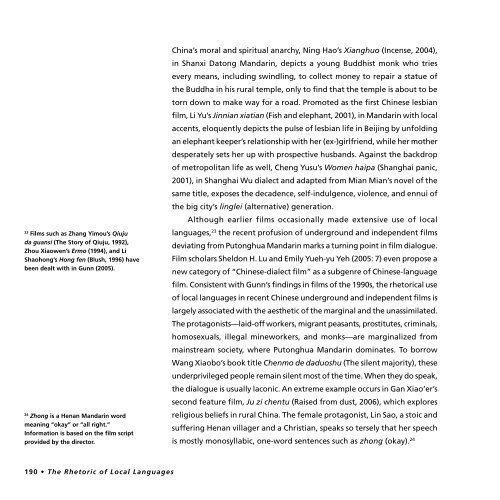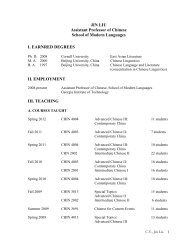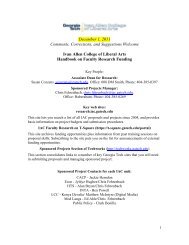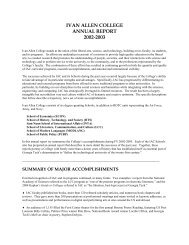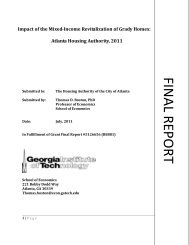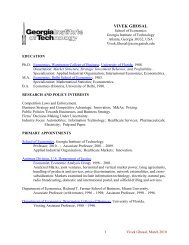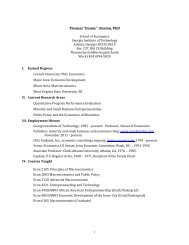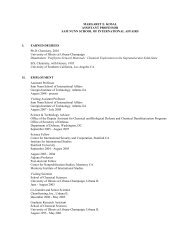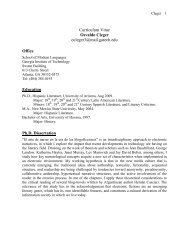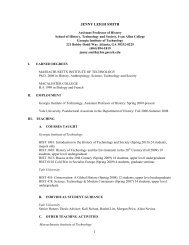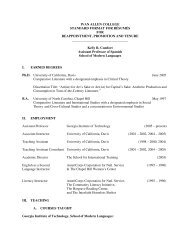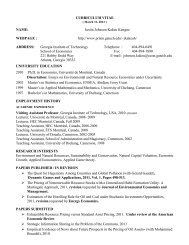Read this paper
Read this paper
Read this paper
You also want an ePaper? Increase the reach of your titles
YUMPU automatically turns print PDFs into web optimized ePapers that Google loves.
China’s moral and spiritual anarchy, Ning Hao’s Xianghuo (Incense, 2004),<br />
in Shanxi Datong Mandarin, depicts a young Buddhist monk who tries<br />
every means, including swindling, to collect money to repair a statue of<br />
the Buddha in his rural temple, only to find that the temple is about to be<br />
torn down to make way for a road. Promoted as the first Chinese lesbian<br />
film, Li Yu’s Jinnian xiatian (Fish and elephant, 2001), in Mandarin with local<br />
accents, eloquently depicts the pulse of lesbian life in Beijing by unfolding<br />
an elephant keeper’s relationship with her (ex-)girlfriend, while her mother<br />
desperately sets her up with prospective husbands. Against the backdrop<br />
of metropolitan life as well, Cheng Yusu’s Women haipa (Shanghai panic,<br />
2001), in Shanghai Wu dialect and adapted from Mian Mian’s novel of the<br />
same title, exposes the decadence, self-indulgence, violence, and ennui of<br />
the big city’s linglei (alternative) generation.<br />
Although earlier films occasionally made extensive use of local<br />
23<br />
Films such as Zhang Yimou’s Qiuju<br />
da guansi (The Story of Qiuju, 1992),<br />
Zhou Xiaowen’s Ermo (1994), and Li<br />
Shaohong’s Hong fen (Blush, 1996) have<br />
been dealt with in Gunn (2005).<br />
languages, 23 the recent profusion of underground and independent films<br />
deviating from Putonghua Mandarin marks a turning point in film dialogue.<br />
Film scholars Sheldon H. Lu and Emily Yueh-yu Yeh (2005: 7) even propose a<br />
new category of “Chinese-dialect film” as a subgenre of Chinese-language<br />
film. Consistent with Gunn’s findings in films of the 1990s, the rhetorical use<br />
of local languages in recent Chinese underground and independent films is<br />
largely associated with the aesthetic of the marginal and the unassimilated.<br />
The protagonists—laid-off workers, migrant peasants, prostitutes, criminals,<br />
homosexuals, illegal mineworkers, and monks—are marginalized from<br />
mainstream society, where Putonghua Mandarin dominates. To borrow<br />
Wang Xiaobo’s book title Chenmo de daduoshu (The silent majority), these<br />
underprivileged people remain silent most of the time. When they do speak,<br />
the dialogue is usually laconic. An extreme example occurs in Gan Xiao’er’s<br />
second feature film, Ju zi chentu (Raised from dust, 2006), which explores<br />
24<br />
Zhong is a Henan Mandarin word<br />
meaning “okay” or “all right.”<br />
Information is based on the film script<br />
provided by the director.<br />
religious beliefs in rural China. The female protagonist, Lin Sao, a stoic and<br />
suffering Henan villager and a Christian, speaks so tersely that her speech<br />
is mostly monosyllabic, one-word sentences such as zhong (okay). 24<br />
190 • The Rhetoric of Local Languages<br />
MCLC 18.2.indd 190<br />
12/20/06 2:01:39 PM


